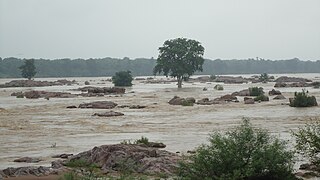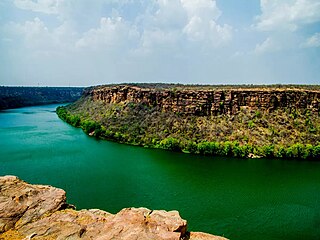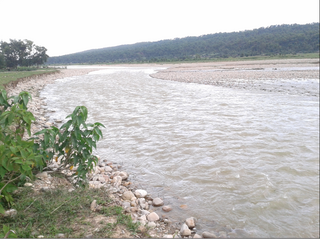The Karmanasa River is a tributary of the Ganges. It originates in Kaimur district of Bihar and flows through the Indian states of Uttar Pradesh and Bihar. Along the boundary between Uttar Pradesh and Bihar it has the districts of Sonbhadra, Chandauli, Varanasi and Ghazipur on its left ; and the districts of Kaimur and Buxar on its right.

The Mahanadi River is a major river in East Central India. It drains an area of around 132,100 square kilometres (51,000 sq mi) and has a total length of 900 kilometres (560 mi). Mahanadi is also known for the Hirakud Dam which was the first major multipurpose river valley project after India's independence in 1947. The river flows through the states of Chhattisgarh and Odisha and before finally ending in the Bay of Bengal.

The Ken River is one of the major rivers in the Bundelkhand region of central India and flows through the states of Madhya Pradesh and Uttar Pradesh. It is a tributary of the Yamuna.

The Mahananda River is a trans-boundary river that flows through the Indian states of Bihar and West Bengal, and Bangladesh. It is an important tributary of the Ganges.

The Chambal River is a tributary of the Yamuna River in Central and Northern India, and thus forms part of the drainage system of the Ganges. The river flows north-northeast through Madhya Pradesh, running for a time through Rajasthan then forming the boundary between Rajasthan and Madhya Pradesh before turning southeast to join the Yamuna in Uttar Pradesh state.
The Berach River, a tributary of the Banas River, is a river of Rajasthan state in western India. The river belongs to the Ganga River basin. The Berach originates in the hills of Udaipur district, northeast of Udaipur, and has a length of 157 km and basin area of 7,502 km². It flows northeast through Udaipur, Chittorgarh and Bhilwara districts, joining the Banas near Bigod village of Bhilwara district.
The Dhasan River is a river in central India. A right bank tributary of the Betwa River, it originates in Begumganj tehsil.

The Burhi Gandak River is a tributary of the Ganges. It is known as Narayani in its upper reaches. The Burhi (“Old”) Gandak flows parallel to and east of the Gandak River in an old channel.

Hindon River is an Indian river in that originates from the Shakumbhari devi range in Saharanpur district of Uttar Pradesh and falls into Yamuna river in Noida. Hindon is a tributary of Yamuna and is entirely rainfed, having an approximate catchment area of 7,083 square kilometres (2,735 sq mi).

The Sankh River flows across Jharkhand, Chhattisgarh and Odisha states in India. The river flows for 240 kilometres (150 mi) before it meets the Koel River in Odisha.
Ong River is a tributary of Mahanadi river. It flows across Odisha and joins Mahanadi 240 km (150 mi) upstream of Sonepur where Tel merges. The river rises at an elevation of 457 m (1,499 ft) and runs 204 km (127 mi) before it meets Mahanadi. It drains an area of about 5,128 km2 (1,980 sq mi).

Ib river is tributary of Mahanadi river in North-Eastern Central India. It joins Mahanadi river flowing directly into the Hirakud Reservoir. The river originates in hills near Pandrapet at an elevation of 762 metres (2,500 ft). It passes through Raigarh district and Jashpur district of Chhattisgarh and Jharsuguda and Sundargarh District of Odisha and finally meets Mahanadi at Hirakud Dam in the state.
The Kiul River is a tributary of Ganges. It originates in Giridih of Jharkhand and flows through Lakhisarai, Sheikhpura and Jamui districts of the Indian state of Bihar and joins Harohar river in the Diara region.

The Kali River, commonly known as Kali Nadi, originates in the Upper Sivaliks and passes through Saharanpur, Muzaffarnagar and Baghpat districts, before merging with Hindon River, which goes on to merge with the Yamuna River, which itself goes to merge with the Ganga River, which finally merges with the Bay of Bengal. The total length of the river from its origin up to its confluence with the Hindon river is 150 km. The river is named Kali, because of the Hindu Goddess Kali.

Konar dam is the second of the four multi-purpose dams included in the first phase of the Damodar Valley Corporation. It was constructed across the Konar River, a tributary of the Damodar River in Hazaribagh district in the Indian state of Jharkhand and opened in 1955. The place has scenic beauty and has been developed as a recreational spot.
The Konar River is a tributary of Damodar River in Hazaribagh and Bokaro districts of the Indian state of Jharkhand.

The Kamala River originates from Nepal and flows through Indian state of Bihar.

Tilaiya Dam was the first of the four multi-purpose dams included in the first phase of the Damodar Valley Corporation. It was constructed across the Barakar River, at Tilaiya in Koderma district in the Indian state of Jharkhand and opened in 1953.
Sukli is a river flowing through Chittorgarh district, Rajasthan, India. Karmai and Sukli are the major tributaries of the Jakham river. Sukli Dam was built on this river.
The Panam Dam is constructed over the Panam River in India. It is located at Santrampur Taluka of Mahisagar district in Gujarat state. Panam is a tributary of the Mahi River, it originates from Devgadh Baria Taluka of Dahod district. The Panam river merges with the Mahi river 25 kilometres (16 mi) downstream of the Panam Dam.












